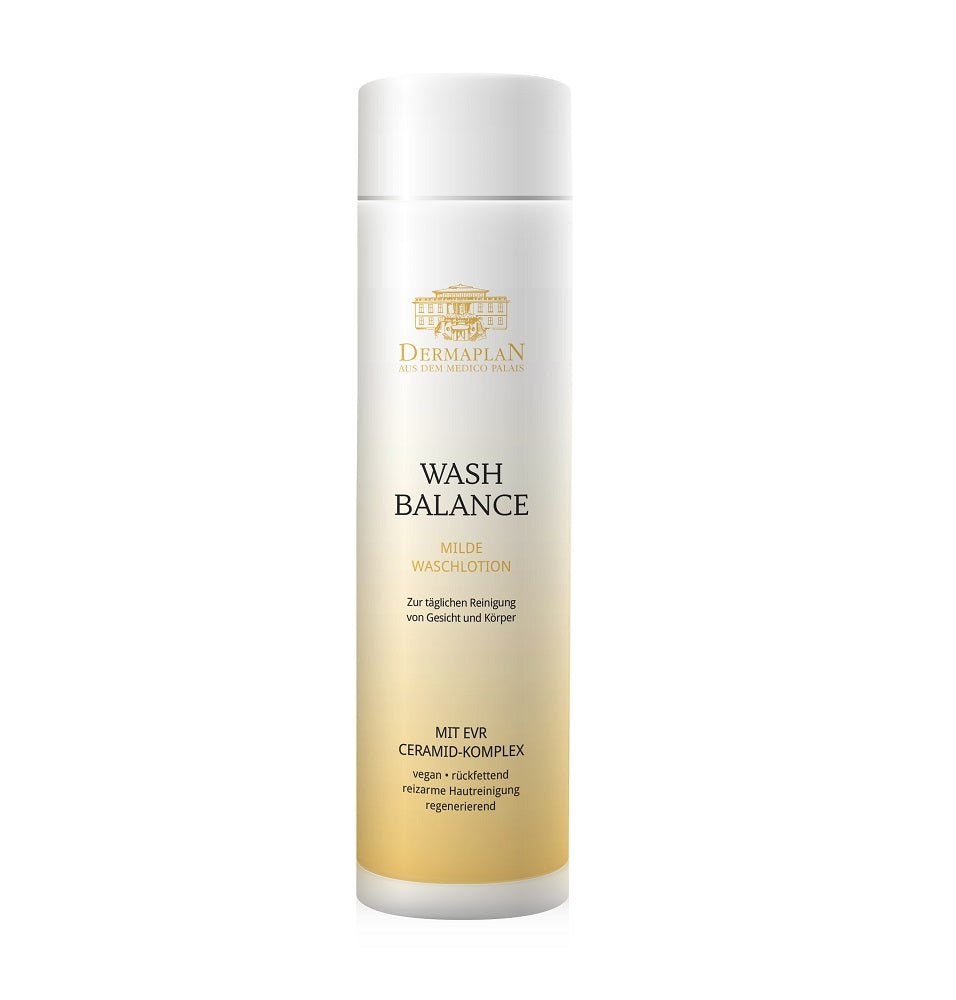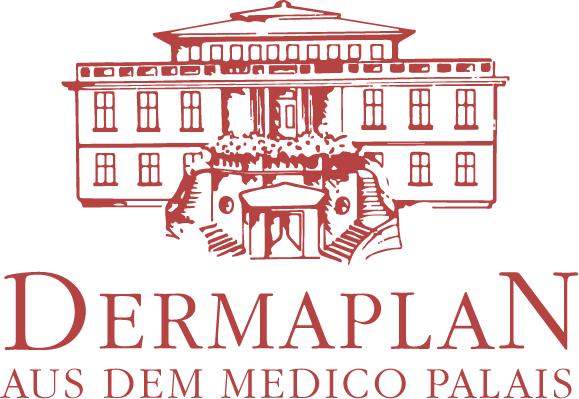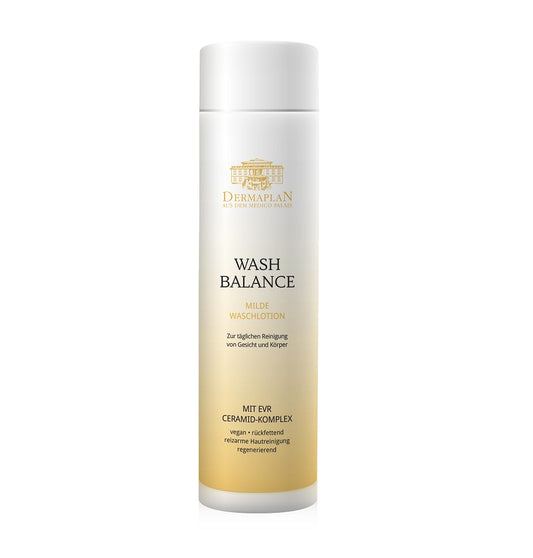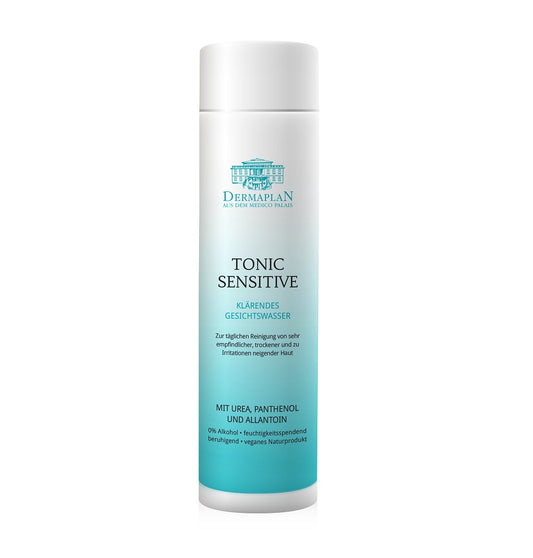ATOPIC DERMATITIS
What is atopic dermatitis?
What you should know about atopic dermatitis: Atopic dermatitis is a chronic or chronically recurring inflammatory skin disease associated with severe itching and usually occurring in bouts. The intensity of the symptoms depends partly on the age of the affected person and can severely limit quality of life. Atopic dermatitis is NOT a contagious disease. While it is considered incurable, it is very treatable, so that a reduction in itching and dry skin can be achieved through a wide variety of treatment options.
Neurodermatitis – a widespread problem
Around four million people in Germany alone suffer from atopic dermatitis. Almost one-eighth of the population in Western industrialized nations is diagnosed with this condition. The disease usually develops in young children and tends to improve with age. In some cases, symptoms are very mild, while in others, atopic dermatitis is particularly severe. Overall, however, children are affected more often than adults. For some, it accompanies them throughout their lives, but symptoms often diminish during puberty. Nevertheless, the skin remains in need of care throughout life because it is dry and sensitive.
In atopic dermatitis, the stratum corneum lacks fats and moisturizing factors. This impairs its barrier function, and it cannot adequately protect the body from pathogens. The exact cause of this disease has not yet been conclusively determined. However, it is certain that there is a genetic predisposition. It is assumed that certain triggers – so-called provocation factors – lead to outbreaks. These can include hormonal fluctuations, stress, smoking, allergies, or even sweating.
Climate and season also play a role. The cold temperatures of winter combined with dry air from heating systems are just as unfavorable as heat and strong sunlight. Another problem is the use of improper cosmetics and cleaning products containing irritating ingredients. The triggers ultimately cause the outbreak depend on the individual.
Soothing for damaged skin
A healthy skin barrier is resilient and protects against irritation. Above the dermis is the stratum corneum. It gets its name from the stratum corneum cells that are bound together with lipids. Its function is not only to ward off external influences but also to prevent moisture loss. In atopic dermatitis, the stratum corneum is less robust because it lacks lipids and is only partially able to retain moisture. As a result, the skin is more permeable, allowing allergens to penetrate more easily. This increases the risk of irritation and inflammation.
Itching causes those affected to scratch the affected areas. This further aggravates the condition, causing further damage to the skin. Irritants and allergens consequently penetrate the compromised protective barrier even more easily. While up to 15 percent of young children suffer from atopic dermatitis, the number in adults is between two and four percent. However, adults often experience a more severe course.
There are also differences in the affected skin areas. In infants, atopic dermatitis occurs primarily on the cheeks and the outer sides of the legs and arms – less frequently on the abdomen, chest, and back. In later years, the neck, elbows, backs of the knees, palms, and soles of the feet become problematic areas. Less commonly, the face may also be affected. Regardless, treatment with creams or ointments is required. In addition to an itch-relieving effect, they also help by inhibiting inflammation.
Skin care for atopic dermatitis
Atopic dermatitis requires continuous skin care. Accordingly, it's important not only to react to symptoms as they occur, but also to take preventative measures. Most sufferers have to deal with dry skin their entire lives. Therefore, basic skin care, as dermatologists call it, is essential. The associated goal is to stabilize the skin barrier. This should make it possible to delay, mitigate, or even prevent flare-ups of the disease. Furthermore, even during symptom-free periods, it can be assumed that underlying inflammation of the skin often exists, and that the barrier as a whole is impaired.
When cleansing daily, it's important to remember that every wash dissolves oil and moisture from the skin. Water alone can do this. Certain soaps and other cleansers intensify this effect unless they are pH-neutral. Dermaplan Wash Balance is an ideal product, as it benefits users from its moisturizing properties. As with all of the brand's products, it contains no allergenic or harmful ingredients. Instead, it gently cleanses the skin. Tonic Sensitive is also gentle, a clarifying facial toner that is alcohol-free. Instead, panthenol, urea, and allantoin strengthen the damaged barrier and moisturize it.
Skin care for atopic dermatitis also includes regular moisturizing, ideally morning and evening. This ensures that the oil and moisture content remains as even and sufficient as possible. Ultimately, this strengthens the skin barrier and improves its condition in the long term. There are two simple but helpful rules: oil on dry skin and moist on moist. This means that products with a high oil content care for dry skin because they prevent moisture loss. However, if the skin is wet, creams with a higher water content should be used, as they have a cooling and drying effect.
It's also a good idea to adjust the oil content to the season. In the winter months, the protective covering is drier than in the summer and therefore needs more oil. Dermaplan offers the Lipid Balance series, which has a fat content of 15, 30, or 42 percent, depending on the product. Acute Itching Care can quickly bring the symptoms of atopic dermatitis under control. Long-term Itching Care, meanwhile, is used as a preventative measure.
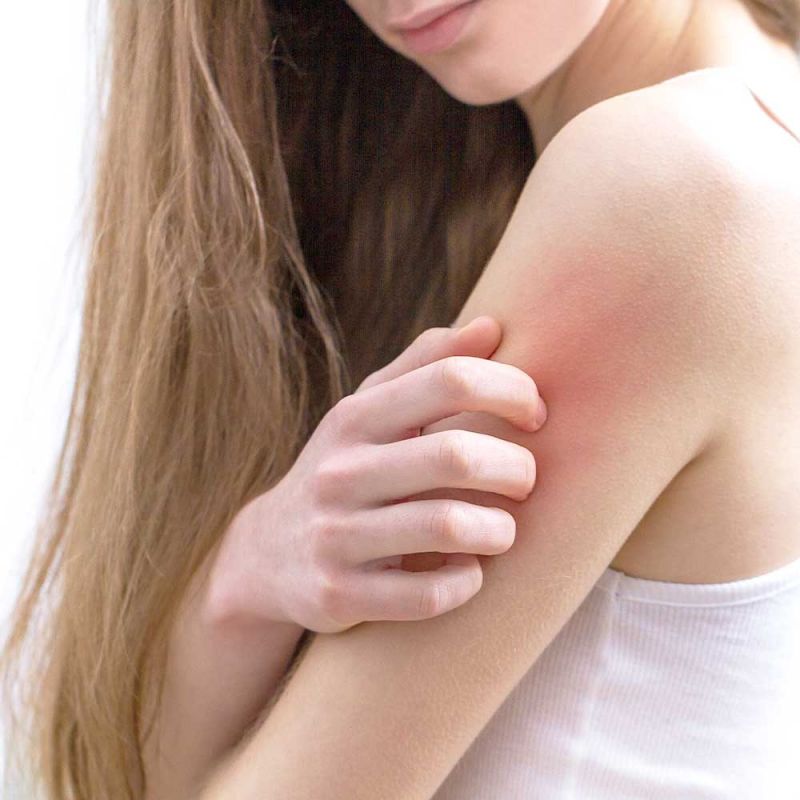
Symptoms of atopic dermatitis
The symptoms of atopic dermatitis usually vary depending on the age of the affected person and can vary greatly in intensity. However, a characteristic of every age is that atopic dermatitis always occurs in phases, so that a symptom-free period is always followed by a period with sometimes extreme symptoms.
The most common symptoms are:
• Dry and reddened skin
• Scaly and sometimes weeping skin
• Usually severe itching
• Occurs in phases
• Scratching often causes eczema
• Tendency to allergic asthma
• Tendency to allergic rhinitis and allergic conjunctivitis
Forms of neurodermatitis
There are two types of atopic dermatitis: the intrinsic and the extrinsic types.
If a patient suffers from the intrinsic type of atopic dermatitis, this means that their blood levels for so-called IgE antibodies are normal. In this case, only mild atopic dermatitis usually develops, without additional respiratory allergies. This type of atopic dermatitis is more common and is often considered a precursor to the extrinsic type of atopic dermatitis.
In the extrinsic type of atopic dermatitis, blood levels show IgE antibodies. Therefore, in these cases, the likelihood of also developing asthma or hay fever is higher.
Atopic dermatitis in infants
-
Neurodermatitis is very common in children. The disease is also known as "atopic dermatitis" or "atopic eczema." It is considered the most common chronic skin disease in children.
-
In Europe and North America, 2.5 to 5% of the population is affected. The risk of suffering from atopic dermatitis is 30% if one parent has the disease, and unfortunately, up to 60% if both parents have it. Atopic dermatitis often shows pathological reactions to environmental factors.
-
A hereditary predisposition to atopic dermatitis can be detected in approximately two-thirds of patients. Initial symptoms of atopic dermatitis appear in 80% of patients during the first two years of life.
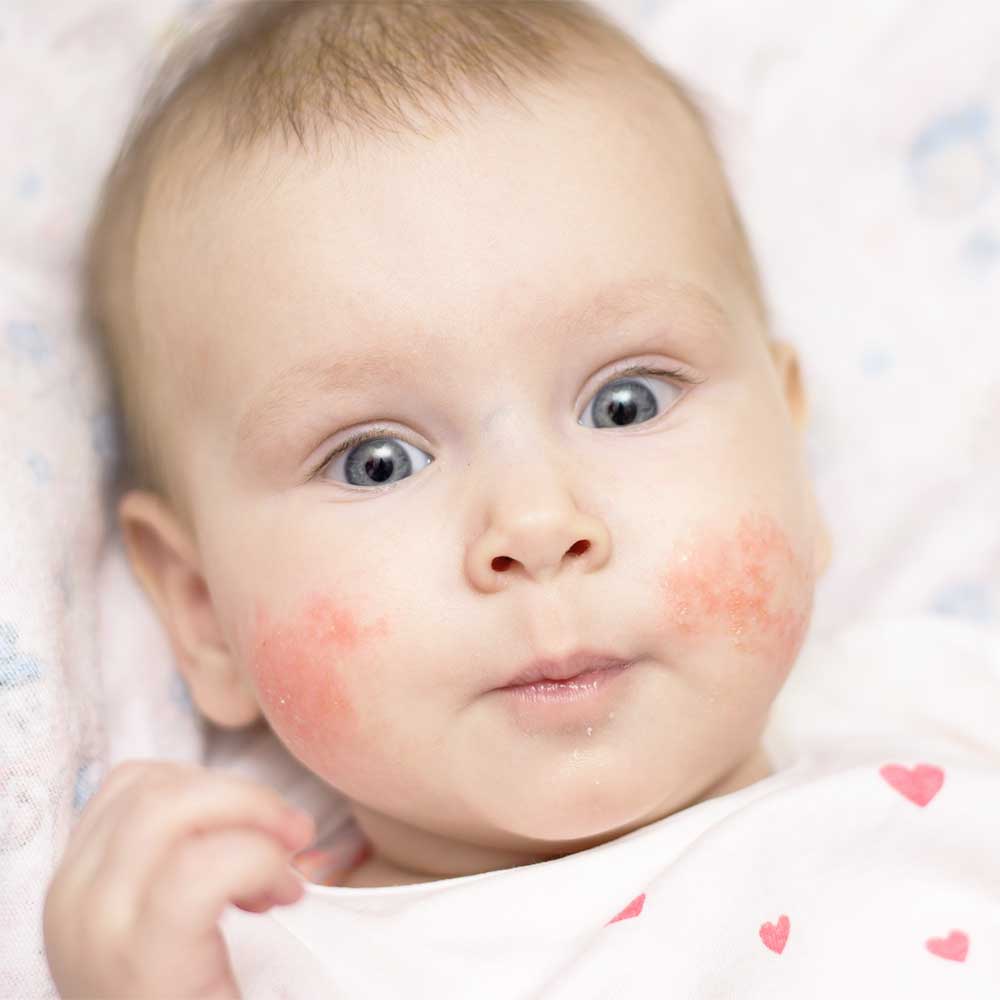
In babies, the course of atopic dermatitis usually begins on the face and scalp: this is where cradle cap forms. This is a yellowish-white, scaly crust on the reddened scalp. These skin changes may also ooze. At this age, atopic dermatitis is also usually seen on the extensor surfaces of the arms and legs, and sometimes a weeping eczema develops in the mouth area.
In children with atopic dermatitis, the skin's natural fatty layer is too thin and the skin barrier is impaired, significantly reducing the body's protection against external irritants. In addition, their impaired immune system reacts hypersensitively to stimuli. Skin redness and itching are the result.
As early as the first year of life, affected children develop flexural eczema, i.e., reddened, scaly, and crusted patches of skin in the creases of, for example, the backs of the knees, elbows, and/or wrists. The skin is simultaneously wet and dry, with little ability to retain moisture. Consequently, increased itching develops.
With age, these patches of skin thicken (lichenification) and become coarser. Furthermore, these areas of skin may be hyper- or hypopigmented—that is, they may be either too darkly or too strongly colored.
Symptoms of atopic dermatitis appear in approximately 60% of children within the first 12 months of life. By kindergarten age, atopic dermatitis has broken out and been diagnosed in approximately 90% of affected children. However, in the following years up to puberty, the disease progresses positively in most children, and symptoms decrease.
Atopic dermatitis in adults
If a person affected by atopic dermatitis persists beyond puberty, the symptoms usually appear in conjunction with the person's professional activity and the skin reacts to various environmental stimuli, for example, with a renewed flare-up of the disease.
-
In affected adults, atopic dermatitis usually appears in the eye and forehead area, the neck, the flexor surfaces of the extremities, and the backs of the hands or feet. However, some patients develop only mild atopic dermatitis with inflammation of the lips (cheilitis), small skin cracks (fissures) in the corners of the mouth, around the ears, or on the fingertips (pulpitis sicca), and nipple eczema.
-
After a long-term course of the disease, for example, the skin may become coarser and thicker, caused by constant rubbing and scratching. The stratum corneum often thickens on the palms of the hands and soles of the feet, leading to deep, painful fissures. Chronic inflammation and chronic rubbing lead to increased skin pigmentation, particularly in the neck area, the so-called "dirty neck."
-
Atopic dermatitis in adults is mainly characterized by:
• A so-called leathery thickening of the facial skin (facies leonina)
• The extensive leather-like thickening of the skin (lichenification)
• Severe itching
• Irritability
• Small itchy skin nodules (prurigo nodules)
Possible causes and symptoms of atopic dermatitis
Unfortunately, the causes of atopic dermatitis are not fully understood. However, both genetic and specific trigger factors appear to play a role in the onset of the disease or its flare-ups.
Often, with increasing age, there is a spontaneous improvement in symptoms or (not infrequently) complete resolution of the disease. The skin changes can regress in half of patients by the age of 20. However, since the genetic predisposition persists, various factors can trigger a new flare-up at any time. 30-50% of all patients also develop another atopic disease, such as hay fever or asthma.
The most common provocation or trigger factors in atopic dermatitis include
Factors that can promote the outbreak of the disease or encourage a flare-up are called provocation or trigger factors.
• Sweat
• Climate – cold, humid, dry
• Hormones (e.g. during menstruation)
• Flower pollen
• Animal hair
• House dust mites (feces)
• Nicotine
• Preservatives, perfume
• Ozone, chlorine
• Stress, tension
• Textiles / skin contact with wool
• Drying of the skin due to too frequent bathing/washing (especially in small children)
• Various foods
In patients with atopic dermatitis, the skin barrier is disrupted. This causes extreme dryness, irritability, and water loss in the skin. This makes it easier for allergens to penetrate the skin and trigger a flare-up of atopic dermatitis. During a flare-up, the affected person's immune system overreacts to otherwise harmless stimuli, resulting in an inflammatory reaction accompanied by severe itching.
"In recent decades, the incidence of atopic dermatitis has increased significantly in the Western world."
For example, in childhood, dry skin is more likely to occur due to frequent bathing and washing, and in approximately 15-20% of patients, inhalation allergies to pollen, pet hair, and house dust mites occur, but allergic reactions to foods, for example, are less common. In adulthood, however, these allergic reactions are rarely triggered. Instead, emotional stress represents a major risk factor.
Avoiding these factors is essential to effectively manage atopic dermatitis. Therefore, it's crucial for each sufferer to identify the most important triggers for them, so they can then avoid them accordingly.
In patients with atopic dermatitis, the skin barrier is disrupted. This causes extreme dryness, irritability, and water loss in the skin. This makes it easier for allergens to penetrate the skin and trigger a flare-up of atopic dermatitis. During a flare-up, the affected person's immune system overreacts to otherwise harmless stimuli, resulting in an inflammatory reaction accompanied by severe itching.
But what is responsible for this? It's a question that's widely discussed among experts. The likely obvious answer is that a change in lifestyle is responsible for the increase in cases of atopic dermatitis. Hygiene standards are now much higher, and as a result, there's significantly less contact with various environmental substances. As a result, some people's immune systems react to what are otherwise harmless stimuli. Washing habits have also changed over the past few decades. This may compromise the skin barrier, causing the skin to react more sensitively.
Examinations and diagnosis of atopic dermatitis
If you suspect you or your child has atopic dermatitis, a visit to a doctor is essential. The doctor will determine the diagnosis and...
…if 3 of the following 4 main criteria apply:
• Severe itching
• Typically distributed eczema (age-appropriate)
• Chronic or recurring symptoms
• Pre-existing atopic disease (such as pollen allergy, asthma) in the child or a close relative
…and 1 of the following 4 secondary criteria is met:
• Elevated blood levels of IgE antibodies
• Positive allergy test (prick and intracutaneous test) for possible allergens
• White dermographism (after mechanical irritation of the skin, e.g. with a spatula or fingernail, the skin pales instead of reddening)
Since there are of course other skin diseases with similar symptoms, it is extremely important to be able to rule them out if neurodermatitis is suspected.
"For further and better diagnosis and to find the best possible treatment, it is advisable to consult a dermatologist and possibly also an allergist."
• Psoriasis or ringworm (hands/feet)
• Other eczemas (general contact dermatitis, irritant-toxic contact dermatitis, microbial dermatitis)
• In adults: Eczema stage of cutaneous T-cell lymphoma (a form of cancer of the lymphatic system)
• In infants: seborrheic dermatitis or other rare syndromes (e.g. metabolic disorder)
• Scabies (scabies)
Helpful tips for treating atopic dermatitis
For those suffering from atopic dermatitis, proper skin care is essential. Below we would like to give you some valuable tips, especially with regard to skin care.
The right skin care can help break the itch-scratch cycle and sustainably build and regenerate the skin's protective barrier.
Those affected should apply cream regularly, as consistent care helps improve the damaged skin barrier and protect the skin from external irritants. These can include viruses and bacteria, as well as sweat and detergent residues in clothing. Therefore, it's important to use appropriate creams even during symptom-free periods – because the predisposition remains, thus delaying a recurrence of atopic dermatitis.
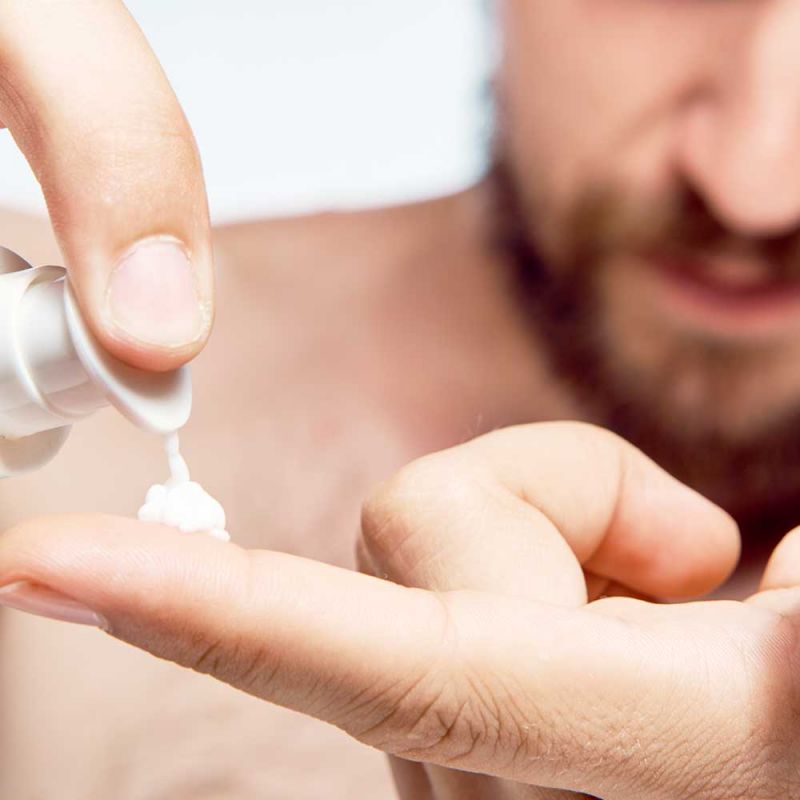
It's important that the skincare products are as lipid-replenishing, moisturizing, and free of allergenic ingredients as possible. Depending on whether you're experiencing an acute flare-up or the season, oil-rich or water-based skincare products may be more effective. For basic daily care, creams or lotions with a higher water content are generally recommended. Dry and chapped skin, on the other hand, benefits more from a more oily skincare cream—it's best to apply this only to the affected area.
DERMAPLAN offers a complete range of products to provide comprehensive care for the troubled skin of people with atopic dermatitis. If you're experiencing itching, you should first use anti-itch care to relieve or even stop it. This will break the itch-scratch cycle and allow you to move on to supportive, long-term preventative skin care. To prevent severe atopic dermatitis flare-ups, consistent skin care is very important, even during symptom-free periods. The skin's protective barrier is sustainably regenerated and strengthened, making your skin better equipped to resist external irritants.
Our skin care recommendation for neurodermatitis itching
• Cleanse your face and body with the mild cleansing lotion every morning and evening. Gently pat your face dry—do not rub.
The Wash Balance is available in 200ml.
• After cleansing with the cleansing lotion, use the mild facial toner with nourishing ingredients that are alcohol-free. Facial toner removes any remaining residue from the skin, revitalizes, nourishes, and improves the texture of redness.
The Tonic Sensitive is available in 200ml.
• Apply the Acute Itching Cream to your itchy skin several times a day, or as needed. Continue using the Acute Itching Cream until you achieve the desired relief. This may take a few days.
The Itching Acute Care is available in 50ml.
Dermaplan Washbalance for face and body 200ml
Our skin care recommendation for atopic dermatitis after itching
• Cleanse your face and body with the mild cleansing lotion every morning and evening. Gently pat your face dry—do not rub.
The Wash Balance is available in 200ml.
• After cleansing with the cleansing lotion, use the mild facial toner with nourishing ingredients that are alcohol-free. Facial toner removes any remaining residue from the skin, revitalizes, nourishes, and improves the texture of redness.
The Tonic Sensitive is available in 200ml.
• Then apply a rich base cream to your face and body. Lipid Balance 3, with approximately 42% lipids, is particularly suitable as a night cream. Lipid Balance 2, with approximately 30% lipids, is sufficient as a day cream. If you prefer a less rich cream, Lipid Balance 1, with approximately 15% lipids, is suitable.
Lipid Balance 1 is available in 50ml and 150ml.
Lipid Balance 2 is available in 50ml and 150ml.
Lipid Balance 3 is available in 50ml and 150ml.
Dermaplan Tonic Sensitive 200ml
-
For our DERMAPLAN products, the principle of “more is better” does not apply. Given the good regenerating and protective properties of our care products, less is more and therefore the products should always be applied thinly.
-
Our DERMAPLAN products are free from allergenic ingredients such as emulsifiers, mineral oils, preservatives, perfume, dyes, silicones, animal ingredients and cortisone, so that your skin is not additionally burdened and a consistent re-fatting of the skin is ensured.
-
A quick tip for your hands: Always rinse off soap thoroughly when washing your hands, as soap residue can unnecessarily irritate the skin. When showering, the thin, protective film of oil on the skin is washed away by the water jet. Few shower heads have a sufficiently gentle water jet that doesn't damage the skin's barrier. Hot water and various bath additives can further dry it out.
Washing and showering with atopic dermatitis
• If possible, shower/bathe only every other day.
• After showering/bathing, gently pat your skin dry – do not rub it dry.
• The water temperature should not exceed 32°C and the shower time should be less than 5 minutes.
• Do not bathe for longer than five to ten minutes. If possible, use water additives containing oil, as these have a moisturising effect.
• After showering/bathing, always apply a medical skin care product specifically for neurodermatitis, e.g. DERMAPLAN skin care.
When an acute flare-up occurs, moist compresses with black tea can also have a soothing and anti-inflammatory effect on the skin. In addition to the options of appropriate basic therapy and drug treatment for atopic dermatitis, other measures are available that can make life with this chronic skin condition easier.
Further measures for atopic dermatitis
-
Training / Therapy / Relaxation techniques
For example, a course on atopic dermatitis has proven effective, allowing those affected or parents to learn more about coping with the condition with their children. In individual cases, psychotherapy can also have positive effects—studies in this area have proven its effectiveness.
In order to reduce or even avoid stress, relaxation techniques such as autogenic training, progressive muscle relaxation, meditation exercises, Tai Chi or yoga can be extremely helpful.
-
Change environmental factors
Atopic dermatitis should also be considered when choosing a career. Typical occupational stresses such as wet work, high levels of dust, and excessive sweating often worsen the skin's condition and can trigger flare-ups.
-
Climate change
Furthermore, a change of climate, for example, also has a beneficial effect on patients suffering from atopic dermatitis. High mountain climates (few allergens, stimulating climate) and sea air, such as those found on the North Sea islands, are recommended. Many sufferers also tolerate the pleasant climate on the Canary Islands particularly well. However, climate therapy usually only leads to stabilization of the condition if the stay is at least three weeks.

Change your diet
In general, for atopic dermatitis patients, foods can trigger a reaction, but they don't always. While one food may worsen the skin in one sufferer, it may improve the skin condition in another. Therefore, a general statement regarding nutritional therapy is unfortunately not possible.
But there are some general rules: A balanced diet strengthens the body against infections that can trigger flare-ups. Alcohol and strong spices can be problematic because they increase blood flow to the skin, which in turn worsens the itching.
You should also use quickly absorbed sugars – such as those found in sweets and white flour products – sparingly, as they generally promote inflammatory processes in the body. Antioxidants (e.g., vitamins A, C, and E, carotenoids, the trace elements selenium and zinc, and various secondary plant substances) have an anti-inflammatory effect and are found in large quantities in the following foods: blueberries, tomatoes, corn, potatoes, carrots, onions, millet, nettles, broccoli, kale, and nuts.
Be sure to drink plenty of water – at least 2 liters a day. Water is important for the breakdown and removal of histamine. Avoid foods and drinks high in histamine, such as red wine, Emmental cheese, or salami. If possible, eat a healthy, light, and varied diet. Prioritize organic foods, dairy products, and meat and sausages from animals raised under humane conditions.
-
Avoid mites, house dust and pet hair
Unfortunately, areas of the body with increased sweat secretion and a thin stratum corneum are particularly affected. Other triggers include allergens that reach the skin via the air, such as house dust, mites, pet hair, or pollen.
If you are sensitive to dust mites, you should reduce their concentration in your living space by avoiding carpets, plush furniture, and textiles (e.g., curtains). Mite-proof bedding for mattresses, duvets, and pillows is also recommended, and the temperature in the bedroom should not exceed 16°C, as mites can reproduce more easily at higher temperatures.
Animal hair is one of the most well-known allergens and often triggers particularly severe reactions on the skin and mucous membranes. People with atopic dermatitis should therefore avoid keeping animals and sports that involve contact with animals.
-
Choose suitable clothing materials
The choice of clothing can also influence a flare-up of atopic dermatitis. Sheep's wool, for example, should be avoided. Loose-fitting cotton clothing is recommended, and in cooler temperatures, items such as coats, sweaters, scarves, and gloves made of fleece materials are also recommended. Perhaps silver textiles are also considered optimal clothing for atopic dermatitis? Yes, because silver can be woven into textiles. These small fibers can make life with atopic dermatitis easier and also alleviate symptoms. The positive effects of silver have long been known.
-
Miscellaneous
Alternative treatment options such as homeopathy, Schuessler salts and herbal medicine can prevent a recurrence.
It's important for everyone affected to receive support or learn strategies that enable them to cope with the condition in their daily lives. Health insurance companies, adult education centers, and various organizations offer specialized atopic dermatitis training courses. These can help atopic dermatitis patients and their families maintain a high quality of life despite the condition.
Would you like to exchange ideas with other affected people? Then take a look here:
The Neurodermatitis Portal is a non-profit self-help organization for people with neurodermatitis and allergies. It provides a forum where all affected individuals can discuss their issues free of charge. While this isn't a substitute for seeing a doctor, it can often be helpful simply to communicate with someone who has a similar experience.
This guide is intended to provide you with some general advice. However, it should not be used for self-diagnosis or self-treatment, as it is in no way a substitute for a visit to the doctor!
Of course, we would also like to be at your side with advice and support, so we are happy to answer your questions – including those about our products – by phone or email.
FAQ Atopic Dermatitis
Atopic dermatitis is one of the most common skin diseases. It occurs in phases – symptom-free periods alternate with more acute phases accompanied by redness, itching, and inflammation. This phenomenon has seen a sharp increase, particularly in the past three decades: the increase has been as much as 300 percent. Naturally, with such a complex topic, there are still unanswered questions in many areas. We address the most common ones here and provide the corresponding answers.
Where on the body does atopic dermatitis occur?
In babies, atopic dermatitis primarily occurs on the scalp as so-called cradle cap and on the face. From about one year of age, flexural eczema may also occur in the creases of the elbows, backs of the knees, and wrists. In adults affected by atopic dermatitis, skin changes are primarily noticeable around the eyes and forehead, as well as around the mouth, throat, neck, shoulder girdle, upper chest region, wrists, backs of the hands, elbows, and backs of the knees.
What should be considered when dealing with atopic dermatitis on the face?
Along with the hands, the face is considered the area of the body most exposed to influences. Examples of such factors include cold, heat, UV radiation, polluted air, and even strong winds. Makeup, sweat, chronic stress, and other unfavorable conditions can also be factors. Even excessively hard water can be a possible cause. Atopic dermatitis on the face is particularly distressing because the condition is immediately recognizable to everyone around you, which can potentially reduce the self-confidence of those affected. Various triggers can trigger a flare-up. Therefore, it is important to pay close attention to possible triggers and to avoid them if possible. In addition, the skin on the face is thinner than on other parts of the body and is therefore more sensitive and in need of more care.
What is important when it comes to skin care for atopic dermatitis?
People with atopic dermatitis should care for their skin regularly – this applies equally to flare-up-free phases. When symptoms aren't present, it's just as important to give it the attention it deserves – the better the protective barrier is strengthened and its condition stabilized. As a result, the symptom-free periods are longer. In this condition, the skin's protective function is impaired. This makes it easier for irritants and allergens to penetrate. Accordingly, a skincare product should avoid such ingredients, which include emulsifiers, preservatives, silicones, fragrances, and perfumes. Dryness is best treated with a dermatologically compatible product that has a moisturizing effect and helps rebuild the protective barrier.
What should be considered when cleansing the skin of atopic dermatitis?
Atopic dermatitis is associated with very dry skin. Accordingly, cleansing should be done with caution: Prolonged contact with water draws even more moisture out. It is therefore advisable to limit washing to five to ten minutes. A mild water temperature is more gentle on the skin than one that is too hot. Atopic dermatitis requires a detergent that is free of fragrances and perfumes, as well as emulsifiers and other irritants. Ideally, it has a refatting effect, thus providing the skin with moisture and lipids. A nourishing cream should always be applied afterward.
